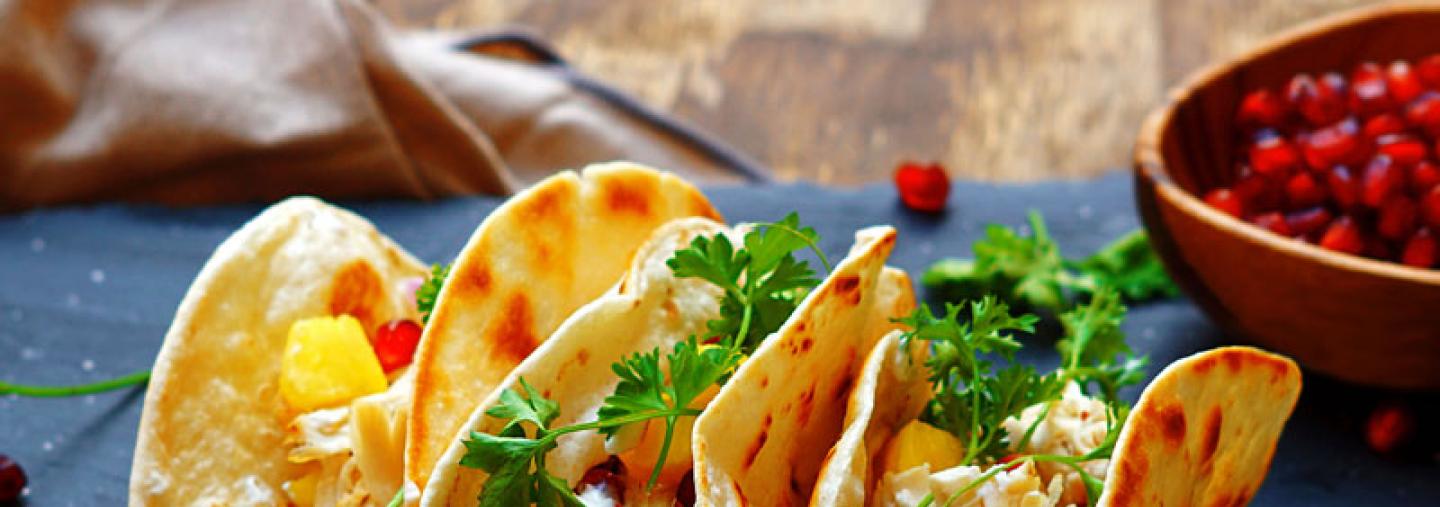Blog

5 Mexican-Inspired Food Trends You Can Bring Home

Go beyond Tex-Mex
It used to be that Mexican-inspired dinner meant Tex-Mex ground beef tacos or piled-high nachos. While those are still go-to delish (and super budget-friendly) options, there is so much more to Mexican food! Increasingly what’s on the menu at restaurants and for home cooks is expanding, based on the growing availability of ingredients and our hunger for what’s new and what’s next!
Let’s take a look at some of the latest trends in Mexican-inspired food.
1. In-home dining
It’s no surprise that more of us are eating at home and flexing our culinary muscles, trying different dishes from around the world. With more and more Mexican ingredients available at stores, authentic Mexican cooking is more accessible for the home chef. What makes Mexican food ideal for at-home dining (or entertaining) is that it has versatility: Short on time, you can pull together a quick dinner with a few flavourful ingredients in mere moments. Wanting to take it up a notch and impress your guests? You can challenge yourself with multi-ingredient dishes and assemble a multi-course feast. Mexican-inspired meals are also flexible in adapting to different dietary needs, and always carry with them an air of casual, relaxed fun.

Consider hosting a Taco Night—virtually! Invite three or four besties to cook a taco recipe together over Zoom. Brainstorm easy taco ideas (or checkout some Mexican-inspired recipes here), decide what you are going to cook, and pick up your ingredients individually. Each participant can pour a glass of Mexican wine (oh so trendy now), beer, juice, or margarita (or a “mock-a-rita.”) Follow the recipe together, share advice and a few laughs, while singing along to some favourite Latin music. When dinner’s ready, you can all sit down together, virtually, make a toast, and enjoy your feast.
Not in the mood for virtual? Have a Summer Backyard/Patio Mexican Night
2. Comfort food
Let’s face it, the world out there can be overwhelming at times, and we long for the solace of simpler times—and rich, comforting flavours.
Mexican-inspired food is seeing a growth in comfort food with homemade styles and flavours like baked enchiladas, pozole (a hearty stew), rich sauces and tortilla soup. And this is no time to skip dessert! Sweet treats (think churros served with hot chocolate or trés leches cake).
Thick and rich, warm, and comforting, mole, one of Mexico’s most beloved sauces, is growing in popularity, as a taste for its unique flavours grows and the availability of its ingredients expands. With mole, regional variations abound. Ingredients (often as many as 30) such as several varieties of chilis, garlic, chocolate, fruit, nuts and seeds, tomatillos, spices, and herbs are simmered and pureed to create a thick pungent sauce that is drizzled over meat, vegetables, tacos, and other classic Mexican dishes. Or, it can be added to soups, stews, or dips for added richness and extra seasoning.
For home cooks, lasagna with a Mexican twist offers both zing for your taste buds and traditional comfort. Casa Mendosa Tortilla Taco Lasagna, with corn, meat and delicious cheese, is baked in the oven for rich, homey flavours. Or try Casa Mendosa Manana Sausage Enchiladas, for classic Mexican-inspired comfort. Check out all our recipes here.

3. Fresh, new ingredients
As the access to more fresh and regional ingredients grows, home chefs will be more empowered to cook from scratch in their own kitchens. Mexican food, in particular, is undergoing a transformation, from standard Tex-Mex burritos and combo plates to more authentic regional specialities.
Mexican ingredients like chilli peppers and cilantro, unavailable in many Canadian grocery stores not that long ago, are now commonplace. Now, Mexican staples like queso fresco, crema Mexicana and chorizo are popping up in stores in some parts of Canada. As ingredients like chipotle, ancho, masa and poblano become part of mainstream restaurant fare, so too has their availability expanded.

The next time you’re feeling Mexican-inspired, try some of these ingredients.
Tomatillos instead of tomatoes: Tomatillos (also known as “tomato verde”) are related to the tomato but are green and covered in a light brown husk. Tomatillos, denser and fruitier than tomatoes, are most often cooked and are the star ingredient in salsa verde.
Jicama: This root vegetable contributes a mildly sweet flavour and a nice crunch to many different Mexican dishes. It is also often eaten on its own as a snack or side dish, sprinkled with lime juice and chili powder.
Cheeses: Mexico boasts a wide array of cheeses. Available in Canadian stores, queso blanco and queso fresco do well inside enchiladas and quesadillas or sprinkled over burritos, tacos or huevos rancheros. Cotija, a sort-of Mexican version of parmesan, is a tangy garnish for salads, tacos or enchiladas.
Herbs: While cilantro, oregano, thyme, parsley and mint are common ingredients in Mexican cooking, hoja santa and marjoram are gaining ground. Chopped hoja santa, with a peppery licorice flavour, is incorporated in a wide variety of Mexican stews, soups and salsas. Marjoram tastes minty and citrusy, with earthy notes. The leaves are added at the end of the cooking as otherwise, it loses its delicate flavour. Marjoram is great to add interest and depth to bean dishes.
4. Veggie-friendly dishes
Foodies from around the world are increasingly looking for veggie-forward, plant-based, or vegan options. Health-conscious diners are incorporating more vegetables into their diets and Mexican cuisine, with its versatility, is happy to oblige.
Greens, like watercress and chard, and vegetables like squash, eggplant and pumpkin, are star players in today’s Mexican dishes and make good sides.
Casa Mendosa® Sweet Potato and Black Bean Tacos are an authentic and delicious vegetarian option. For something vegan, try Casa Mendosa Black Bean Tostadas. Check out these and more vegetarian recipes here.

5. Regional Mexican cuisine
Looking for authenticity? As with many cuisines, Mexican food is incredibly diverse geographically, and there is a growing appreciation of the variety and difference (some subtle, some not so subtle) of the cuisine of the different regions. Not only that, like other cuisines, it is always evolving with influences from other cultures and the introduction of new ingredients.
Check out where some of your favourite dishes have their origins.
Northern Mexico
The traditional dishes of northern Mexico are likely ones you know best. Burritos, anyone? Here, flour tortillas are favoured over corn tortillas, as they are considered to be best for burritos, given their soft pliability.
Refried pinto beans are a popular side dish, as well as Spanish rice. Machaca, dried meat that is rehydrated and simmered in broth, is also common in this area—as is roast baby goat.
The region is host to a strong tradition of ranching, making beef the meat of choice for much of the area. It’s also big on tasty cheeses, like Queso fresco (fresh farmers’ cheese), Queso menonita, Ranchero, Cuajada and Requesón. Think melt-in-your mouth quesadillas or fajitas!
Baja California Peninsula
You can thank this region for bringing you authentic fish tacos. The Baja region has a lot of Spanish- influenced food and is known for its paella, made with fresh seafood. Beyond great seafood, the arid central areas also produce excellent beef cattle. Baja California is also Mexico’s primary wine-growing region, including Santo Tomas, San Antonio, and San Vicente. You’ll find the city of Los Cabos on the Baja Peninsula, which is where fish tacos became famous. Interestingly, this region is also where the Caesar salad was born.
Central Mexico
Central Mexico’s most famous and culturally popular area is Mexico City, which celebrates a vibrant and abundant “street food” culture. This style of cuisine is perfect for the fast-paced city lifestyle and has spawned some amazingly tasty tacos, chalupas, tortas. Enchiladas have their origin here. An original street food, they once were simply corn tortillas dipped in chili sauce.
Like most capital cities, Mexico City also has some incredible fine dining. It also enjoys a middle-eastern influence, with the use of a pita-style bread tortilla for tacos.
Southeast of Mexico City, Puebla is known for its meat wrapped in fragrant leaves and roasted or braised in tomatoes or tomatillos. It’s also famous for mole, the chocolate-tinged sauce.
Southern Mexico
While northern Mexico favours beef as its main meat, the south prefers chicken. And while the north favours flour tortillas, the south favours corn tortillas, which are a staple in this area and are served at almost every meal. Black beans and plantains are also typical ingredients.
The refreshing combination of chicken and fruit is a hallmark of southern Mexican cooking—Guava, pineapple, mango, prickly pear, among many others. Want a Southern Mexican experience? Try Casa Mendosa Chicken and Pineapple Salsa Tacos. It’s easy and bursting with fresh flavours! You use a rotisserie chicken, avocado, cilantro, red onion, lime and juicy fresh pineapple. Check out the full recipe here.

Yucatan Peninsula: Last but not least, Yucatán is a small area that is big on food. The cuisine is different from other parts of Mexico thanks to a strong Mayan tradition and its southern location near the Caribbean. Menus in the Yucatan are also influenced by Asian and Arabic cuisine. Some Yucatan specialties are chiltomate, a sauce made with roasted tomatoes, chilis and onions; papadzules, which are rolled tortillas stuffed with hard-boiled eggs and topped with tomato sauce; poc chuc, pork with achiote and orange. The achiote spice is a signature seasoning in the region, giving foods a distinctive reddish colour and a mild peppery flavour. Habaneros are used as a condiment in many dishes, and tropical fruits like plums, mamey sapote, avocados, tamarinds and bitter oranges are common—adding fresh distinctive flavours.
